|
Bettini’s Latin American Connections
by Robert Feinstein

|
|
CARAS Y CARETAS
(Nov. 16, 1901)
|
|
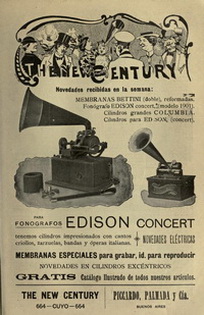
|
|
CARAS Y CARETAS
(Aug. 17. 1901)
|
|
|
In July of 1905, THE EDISON PHONOGRAPH MONTHLY published this comment
by the National Phonograph Company Export Division's new manager: "Until a year ago …
we paid little attention to export possibilities. We are going ahead on the plan of
giving our foreign customers just what they want … We have sold thousands of machines
in Mexico … and have an agent now who is making a tour of South America. The Spanish
speaking people in those countries are great lovers of music … "
Always a visionary, Lieutenant Gianni Bettini had been actively selling his phonographic
wares in Latin America years earlier … shortly after he transformed what had been an
expensive hobby into a commercial enterprise. However, a Bettini link to Hispanic
America even predated this change, although he may not have been aware of it. As early
as 1895, a Bettini talking machine was exhibited at the Grand International Gallery,
No. 12 Santa Clara Alley, in Mexico City. A review in LA VOZ DE MEXICO of June 19, 1895,
described its demonstration and mentioned that no listening tubes were needed to hear the
program of predominantly French music. Paid announcements about this appeared in another
periodical … EL MONITOR REPUBLICANO, on June 28th, July 4th, and July 20th.
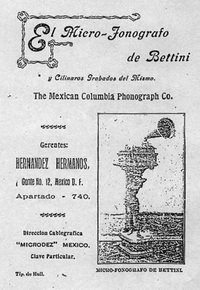
|
|
Hernandez Bros. Bettini Catalogue
(ca. 1899)
|
|
|
Beginning on March 31, 1898, the phonograph firm of Hernandez Brothers, 12 Gante Street,
Mexico City, placed advertisements in the English-language MEXICAN HERALD which declared:
"THE BETTINI MICROPHONE attachment, [the] wonderful invention of a wonderful age, when
attached to an ordinary Phonograph, improves it to such an extent that the sound is unlike
that of instruments thus far considered the best ... " The same broadside continued to be
placed in that newspaper through August 18, 1898.
The contacts between Bettini and Hernandez Brothers must have been extensive, as a ca. 1899
catalogue it produced under the title "El Micro-Fonografo Bettini" made considerable use of
the Lieutenant’s graphics. Even the telegraph address listed on its cover, "MICRODEZ," was
influenced by him.
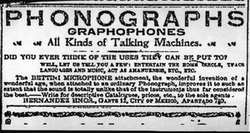
|
|
THE MEXICAN HERALD
(March 31-Aug. 18, 1898)
|
|
|
Mexico City was the site of the first discovery of a Bettini cylinder cache, when collector
Ray Phillips found a group of them in an antiques shop, in 1945. A comparison with the
Bettinis listed in the Hernandez Brothers catalogue showed several exact matches. Writing
in THE HILLANDALE NEWS of October, 1972, Ray mentioned that: "Many of the boxes carried
small one-inch gummed labels reading J. Morales y Cia [which] not only imported phonographic
material from the United States and Spain, but recorded in Mexico City under its own label."
Ray bought quite a few cylinders from the store, and I do not believe any of these J. Morales
recordings were Bettini’s. However, that firm was, by 1901, selling the Lieutenant's product
line, and mentioned his name in advertisements it placed in EL TIEMPO from May through September,
in EL POPULAR on September 14th, and in EL PAIS on September 14, 1901.
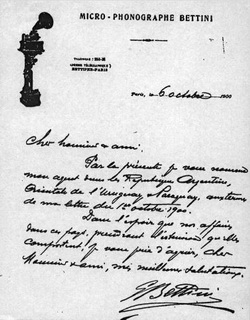
|
|
Bettini’s letter to F. R. Guppy & Company
(Oct. 6, 1900)
|
|
|
By 1900, Lieutenant Bettini had a minimum of three jobbers in Buenos Aires: F.R. Guppy and
Company of 368 San Martin, Piccardo, Palmadie and Company (aka The New Century) of 664 Cuyo,
and Laborde and Company at 368 San Martin. All of them made considerable use of Bettini’s
distinctive illustrations in their announcements. Judging by the frequency in which these
ads appeared, they must have done a brisk trade.
Lieutenant Bettini undoubtedly had especially close
ties with F.R. Guppy, because on October 6, 1900, he
wrote a note, in Spanish, authorizing it to be his exclusive
representatives for Uruguay and Paraguay. So
proud was F.R. Guppy about this assignment that it
reproduced the letter, at least once … in the March 2,
1901 edition of CARAS Y CARETAS. F.R. Guppy may
well have advertised in Uruguay and Paraguay.
Although an autonomous member of the Kingdom of
the Netherlands, a good case can be made that Curacao
is partially Latin American. Originally falling to the
Spanish conquest, it was not governed by the Dutch
until 1734, Curacao’s population primarily speaks Papamiento,
a Creole language that incorporates Spanish
and Portuguese, and Spanish itself, is widely spoken
on the island. Even the name Curacao is believed by
many to be derived from corazon,
the Spanish word for
heart. Just thirty-seven miles from the coast of Venezuela,
Curacao’s cuisine, music, dances, and culture,
in general, have strong Hispanic characteristics. Indeed,
Curacao’s leaders and press have referred to it
as: "The hub to Latin America." Consequently, it is relevant
to include a Curacao-Bettini venture among his
Latin American connections.
The owner's name was Dr. W.C. Gaerste, who at various
times in the newspaper, AMIGOE DE CURACAO,
starting on August 8, 1897, vaunted himself as an
agent for "the Bettini Micro-Attachment." I do not know
what kind of doctor W.C. Gaerste was, but several
things are obvious to me. Firstly, considering Curacao’s
small population, it remains doubtful that Dr. Gaerste
made much of a living selling phonographic items
there. However, Curacao has always had strong economic
ties with Venezuela and Colombia, so it is quite
possible that this Bettini dealer may have been active
in those countries. And secondly, judging by the unattractive
ads Dr. Gaerste issued, it is doubtful that Bettini
had any role in their creation.
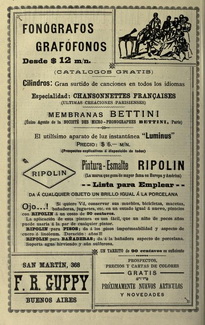
|
|
CARAS Y CARETAS
(July 25, 1901)
|
|

|
|
CARAS Y CARETAS
(Oct. 5, 1901)
|
|

|
|
CARAS Y CARETAS
(Dec. 21, 1901)
|
|
|
I have not determined if Lieutenant Bettini ever visited
Latin America, but that does seem likely. A filler in the
May, 1899 PHONOSCOPE remarked: "Lieut. Bettini,
unlike the majority of people who make a pilgrimage to
foreign lands in search of pleasure, makes two or three
trips each year, combining business and pleasure."
And the July, 1904 issue of THE TALKING MACHINE
NEWS summed it all up when it declared that: "Bettini
is known all over the world."
|